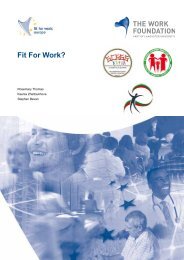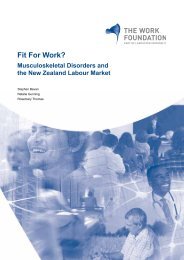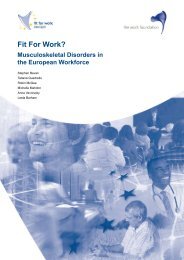English version - Fit for Work Europe
English version - Fit for Work Europe
English version - Fit for Work Europe
Create successful ePaper yourself
Turn your PDF publications into a flip-book with our unique Google optimized e-Paper software.
<strong>Work</strong> and MSDs in Japan<br />
20<br />
3.3<br />
The impact<br />
of MSDs on<br />
ability to<br />
work<br />
the data on work-related compensations is gathered according to the list of occupational<br />
diseases above. Such approach to epidemiological surveys may lead to misleading in-country<br />
and international comparisons. This is a troubling picture <strong>for</strong> a number of reasons:<br />
• Low awareness of the wider economic and societal costs of MSDs, their impact on<br />
productivity, workers and their families delay action necessary to be taken by Japanese<br />
employers and policy makers. For example, the guidelines on low back pain, issued in<br />
1994, are highly relevant <strong>for</strong> prevention of industrial accidents associated with manual<br />
work, yet are not applicable to prevent back pain among office workers.<br />
• If, as is likely, the prevalence of MSDs increases with the ageing of the Japanese<br />
work<strong>for</strong>ce, the absence of good baseline data will complicate <strong>for</strong>ecasting of the future<br />
impact of MSDs.<br />
• The benefits of clinical, labour market or workplace interventions are made all the more<br />
difficult to quantify (or justify) if there are no reliable or comprehensive data on the<br />
extent or impact of MSDs in the Japanese work<strong>for</strong>ce.<br />
While the number of compensation claims <strong>for</strong> MSDs has been decreasing gradually in Japan<br />
(MHLW, 2010c), hinting at a decline in the incidence, this trend may in fact reflect the gaps in<br />
the system of classification of work-related diseases, which restricts the definition of MSDs to<br />
the occupational injuries caused by work. Exclusion of chronic diseases of the musculoskeletal<br />
system, with less obvious links to the work-related causes, may be misleading the reporting of<br />
the prevalence of MSDs.<br />
At the same time, Japanese National Livelihood survey on chronic pain (Nakamura et al., 2011)<br />
revealed that MSDs are the most common reason <strong>for</strong> individuals to be experiencing chronic<br />
pain in Japan (see Figure 3.3).<br />
This section reviews existing data on the prevalence of four MSDs common in Japan.<br />
3.3.1 Back pain<br />
Back pain, back problems and disc disorders are very common complaints in Japan. One<br />
large-scale study reports that of all the respondents experiencing chronic muscular pain, at<br />
least 65 per cent had pain in their low back (Nakamura et al., 2011). Another study reports that<br />
57.1 per cent of males and 51.1 per cent females experienced low back pain severe enough<br />
to seek treatment (Fukuhara, Suzukamo, Morita, Takahashi, Konno et al., 2003). At the same<br />
time, official data is much different from the self-reported prevalence. As the patient survey data<br />
collected by MHLW is based on absence data of four days and longer, the rates of back pain<br />
appear to be much lower: in 2009 only 81 cases of work-related low back pain were recorded,<br />
<strong>Fit</strong> For <strong>Work</strong>? Musculoskeletal Disorders and the Japanese Labour Market







